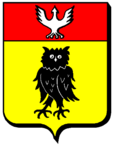Hoeville
| Hoeville | ||
|---|---|---|

|
|
|
| region | Grand Est | |
| Department | Meurthe-et-Moselle | |
| Arrondissement | Luneville | |
| Canton | Lunéville-1 | |
| Community association | Pays du Sânon | |
| Coordinates | 48 ° 42 ' N , 6 ° 26' E | |
| height | 218-328 m | |
| surface | 8.54 km 2 | |
| Residents | 198 (January 1, 2017) | |
| Population density | 23 inhabitants / km 2 | |
| Post Code | 54370 | |
| INSEE code | 54262 | |
 Grande Rue in Hoéville |
||
Hoéville is a French commune with 198 inhabitants (as of January 1, 2017) in the Meurthe-et-Moselle department in the Grand Est region (before 2016 Lorraine ). It belongs to the Arrondissement of Lunéville and the canton of Lunéville-1 (until 2015 the canton of Lunéville-Nord ). The inhabitants call themselves Hoévillois (es) .
geography
The municipality is located about 19 kilometers east-northeast of Nancy in the south of the Meurthe-et-Moselle department. Hoéville lies on the Roanne River and consists of the village of Hoéville and a few individual farms. Neighboring communities are Bezange-la-Grande in the northeast, Athienville in the east, Serres in the southeast, Courbesseaux in the southwest, Réméréville in the west and Sornéville in the northwest.
history
Today's community is first mentioned in 1296 under the name Oheiville in a loan agreement between Renault d'Athienville and Simonin de Damelevières. In the Middle Ages, numerous owners took turns. Hoéville belonged to the bailiwick (Bailliage) Lunéville and thus to the Duchy of Lorraine , which fell to France in 1766. Until the French Revolution , the community was then in the Grand-gouvernement de Lorraine-et-Barrois . The place was badly damaged in the First World War. From 1793 to 1801 the community was assigned to the Lunéville district. Hoéville changed cantons several times. From 1793 to 1801 it was part of the canton of Einville, from 1801 to 2015 of the canton of Lunéville-Nord and since then of the canton of Lunéville-1. Since 1801 Hoéville has also been assigned to the Arrondissement of Lunéville. Until 1871, the community was in the old Meurt (h) e. Since then it has been part of the Meurthe-et-Moselle department .
Population development
| year | 1793 | 1841 | 1911 | 1921 | 1962 | 1968 | 1975 | 1982 | 1990 | 1999 | 2007 | 2015 |
| Residents | 274 | 385 | 258 | 183 | 131 | 130 | 125 | 122 | 115 | 124 | 162 | 197 |
| Source: Cassini and INSEE | ||||||||||||
traffic
Hoéville is far away from national transport connections. The D84, which runs through the village, is important for regional traffic.
Attractions
- Saint-Nicolas village church , rebuilt after the First World War
- Memorial to the Fallen
- Memorial for fallen resistance fighters
- Fortified house from the 18th century






